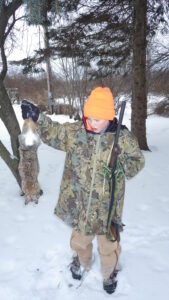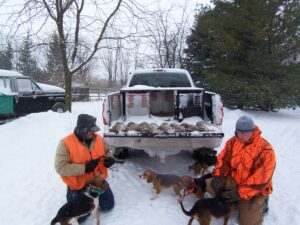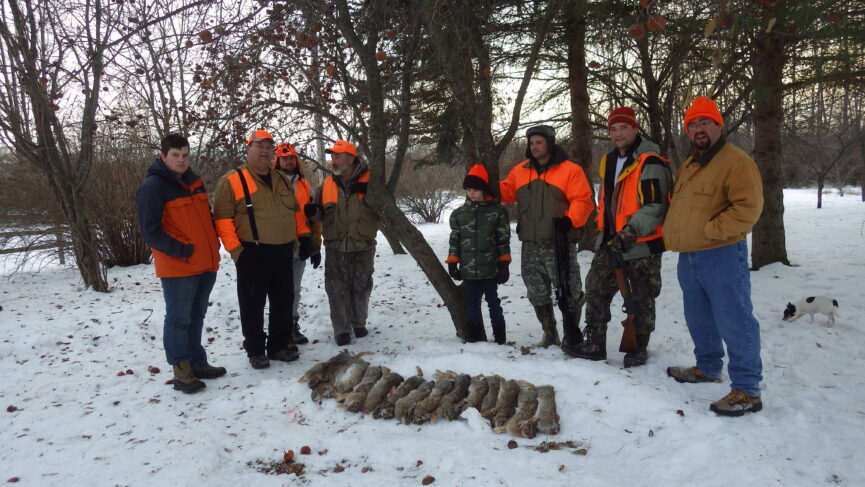
Hugh with his rabbit harvest
Growing up on a Thumb area farm, I have a long association with the cottontail rabbit, a wild, carefree critter which I much admire, and it was the first game animal I ever harvested. This occurred when I was a kid and had just finished my morning chores at the barn and was returning to our farmhouse. When I walked past the corncrib, a cottontail flushed from near it and headed lickety-split to our orchard nearby. I went to the house and grabbed up my single-shot .410 shotgun, and a couple shells.
A fresh, fluffy snow had just fallen, and it didn’t take me long to locate and get on the rabbit tracks which made a meandering course through the orchard. The tracks ended at a pile of snow-covered, pruned apple tree branches, and I held the .410 at port-arms and gave the pile an abrupt kick.
The rabbit suddenly flew out like an airborne jack-in-the-box and hit the ground and was airborne again in a mighty leap when the .410 barked, almost of its own accord, and the headshot rabbit dropped on the spot. I was forever after a smitten rabbit hunter, and I have used that tracking technique for rabbit hunting on fresh snow ever since.
Rabbit meat is very lean and fat-free, but when you dip it in spiced batter and fry it up in butter, it kind of defeats the fat-free purpose. However, it is one of my favorite rabbit recipes and there are many more, including our favorite rabbit noodle soup – cottontails are extremely good and delicious to eat.
In time, I would be introduced by friends to pursuing rabbits with beagles, a very time-honored pastime known as “beagling”. Beagles are a versatile and infectiously happy breed, and there is nothing quite as unique as listening to beagles singing in chorus on a hot rabbit track during a frosty and wintry atmosphere. If you have never witnessed this melodious moment, you are truly missing out on one of the most exhilarating experiences in the outdoors. Hounds baying on a fresh track have a way of quite literally drawing your soul into the hunt, and it is an association as ancient as the relationship of humans with dogs. Maybe you will bag the quarry, and maybe not, but it is the close and very personal bond shared with your canine hunting partners in the field which truly matters in the end.
Whenever I decide to add a lot of rabbits to the pot, I perform a rabbit-drive, also an ancient hunting technique as old as humans being hunters. The real key here is in knowing your ground, which in this case I always refer to as being proper “rabbitat” and it can often be dense, briar-infested cover. Standers need to be placed at pinch-points and in obvious funnels towards known places of refuge for hunter-wise cottontails. Drivers then move through the cover in an organized manner which shakes the highly wary cottontails loose and on the move (hopefully in the right direction), and it can be a very productive method minus any dogs.
In my case, however, I prefer to use dogs as well, and any flushing breed will work, such as Labrador retrievers, even terriers (I once had a dachshund that was a real jewel) and I have never hesitated to use my bird dogs as well. My old beagle “Boomer” (who recently passed away) learned to know the difference between an organized rabbit drive and when he could be, well, a typical beagle (he also knew when he was a “bird-dog”). I am presently using my two female Mountain Curs and female German shorthair pointer as my primary hunting dogs, and they have proven to be very versatile, and take flushing rabbits in stride.
And of course I am one of the pooches too, as I dearly love working with my dogs and driving rabbits to the waiting standers. Hearing gunfire is definitely music to my ears, and despite who does the shooting, it is a teamwork effort shared by all, and I do love to eat rabbit, a very distinct wintertime flavor for me.
I typically do not start hunting cottontails on my farm until our family Christmas gathering, which suddenly catches the rabbits a bit off guard, and if the weather is working in our favor, the action can be fast and furious during our first rabbit drive.
As was expected, our Christmastime family rabbit drive last year netted a bunch of rabbits, and when you are working with dogs, you can readily scour out through the dense “rabbitat” cover and move some bunnies! The key then, is for the standers to hit their mark on often fast moving targets, and to let the dogs afterwards nuzzle and even retrieve downed rabbits, an important part of the hunt ritual. I will never forget hearing my young grandson, Orlando, yelling in a panicked manner, because he had unknowingly picked up a dead rabbit before my female Mountain Cur, Jilly, could retrieve it, and she still wanted to retrieve it, and was leaping all around a startled kid! But they managed to work matters out when Orlando dropped the rabbit, which was a good start.
We’ve often had a lot of rabbits to dress out after a successful rabbit drive (I remember the Christmas we had 19), which can be similar to an assembly (or should I say “disassembly”) line. We always wear rubber gloves to do this because rabbits roam around, live in, and even gnaw on poison ivy which can easily be transferred from their fur to your hands, even in winter. We also never do any of this indoors because a lot of fleas can suddenly wake up on dead rabbits when at room temperature (the same applies to squirrels).

The day’s harvest
Yep, folks, wherever you live in Michigan, which for a fact has bountiful public land available to all, you are never far from true “rabbitat” (I’ve had some fine rabbit hunts not far at all from major cities). Learn to recognize and take advantage of it, and doing so will certainly shorten up long winters and add some great outdoor adventures, not to mention delicious meals as well.

